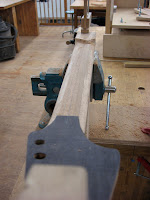The steps: a. choose a font which could I route with a very find routing bit.
b. printed out R. Ponce and glued it to a piece of rosewood
c. routed the letters away leaving an imprint in the wood
d. filled the imprint with silver dust, which I filed off a silver letter removed from an old belt (bought at Goodwill)
e. dropped super glue over the letters (picture)
Next step will be to sand off the glue and shape the truss rod cover.


















































